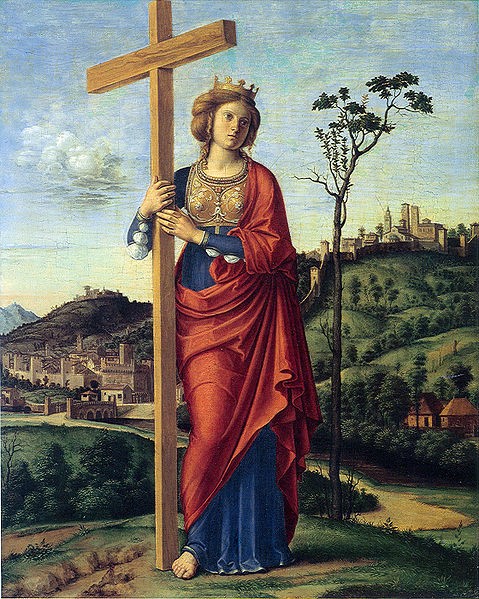This is a legend unlike any other. It all started with a young servant girl named Flavia Julia Helena.1 Born in 248 C.E. in Bithynia, a province of the Roman Empire, Helena was no different from anyone else, until the day that she caught the eye of the Roman emperor Constantius I Chlorus with her beauty.2
They married, had a son in the year 272 who, if you have ever learned anything about Roman history, you will probably know. Their son was the one and only Constantine. Constantine became one of the greatest Roman emperors. One of the things he is known for is the Edict of Milan, issued in the year 313.3 The Edict of Milan allowed for Christianity to be a freely practiced religion. It was at this time that Helena most likely converted to Christianity.4

In the year 324, Constantine sent Helena on a pilgrimage to the Holy Lands in search of the “Holy Sepulcher” and “The True Cross.” The “Holy Sepulcher” is the location of the crucifixion of Jesus Christ, while “The True Cross” is the cross on which Jesus Christ was crucified.5 On this pilgrimage, it was said that Helena “followed in the footsteps of Jesus,” by performing many acts of kindness and good works, such as giving money, food, and clothing to the poor, and also helping churches with funds as well as their other needs.6 After weeks of traveling, they finally made it to Jerusalem. With the help Judas Cyriancus, a man selected at random and forced against his will to help, Helena was able to get closer than she ever had to finding “The True Cross.”7 This is where the story diverges. Although some believe a commoner from a nearby town led Helena to “The True Cross,”others believe that it was Judas Cyriancus.
They continued their search for days, when their prayers were finally answered. Helena said it was then, “With sweet smelling dust and a flash of lighting pointed to the place where,” she instructed Judas to started digging.8 Finally, they uncovered three crosses, one thought to belong to Jesus Christ, and the others belonging to the two thieves that died alongside Him. To test and see which one of these crosses truly belonged to Jesus Christ, they searched for a leper at the outskirts of Jerusalem. Once one was found, they returned back to the site of Golgotha, the place of Jesus’ crucifixion. The leper was instructed to touch each of the crosses one by one. He touched the first one and nothing happened. He touched the second one and still nothing happened. Finally, when he touched the third and final cross, the leper was instantly healed.9 It was this cross that healed the leper, and for that reason it is known as the “The True Cross.”

The cross was then carried back to Constantinople, while part of the cross was placed in the hands of the bishop of Jerusalem.10 As the years passed, fragments of “The True Cross” were placed in the care of many Catholic churches around the world for all to admire. Although we may never know whether the cross they found and distributed was “The True Cross,” like all legends, in the end it is up to us whether to believe the account or not.
- Dictionary of World Biography, 2016 s.v. “Helena, St.” ↵
- Global Events: Milestone Events Throughout History, 2014, s.v. “Saint Helena Makes a Pilgrimage to the Holy Land,” by Jennifer Stock. ↵
- Global Events: Milestone Events Throughout History, 2014, s.v. “Saint Helena Makes a Pilgrimage to the Holy Land,” by Jennifer Stock. ↵
- Dictionary of World Biography, 2016 s.v. “Helena, St.” ↵
- New Catholic Encyclopedia, 2003 s.v. “Helena, St,” by J. H. Geiger. ↵
- Global Events: Milestone Events Throughout History, 2014, s.v. “Saint Helena Makes a Pilgrimage to the Holy Land,” by Jennifer Stock. ↵
- Barbara Baert, “New Observations on the Genesis of Girona (1050-1100). The Iconography of the Legend of the True Cross,” Gesta 38, no. 2 (1999): 117-121. ↵
- Barbara Baert, “New Observations on the Genesis of Girona (1050-1100). The Iconography of the Legend of the True Cross,” Gesta 38, no. 2 (1999): 117-121. ↵
- Barbara Baert, “New Observations on the Genesis of Girona (1050-1100). The Iconography of the Legend of the True Cross,” Gesta 38, no. 2 (1999): 117-121. ↵
- Religious Celebrations: An Encyclopedia of Holidays, Festivals, Solemn Observances, and Spiritual Commemorations, 2011, s.v. “Elevation of the True Cross (September 14),” by J. Gordon Melton. ↵



56 comments
Vania Gonzalez
St. Helena sounded familiar but to me she was not necessarily taught so this was a new read for me, this was interesting because Constantine is well known but I did not know the legend of his mother. At this time in history Christianity was fairly a new thing for many people because it was not allowed before and for Constantine to go and try to find the cross and all of its divinity is ironic.
Roberto Rodriguez
I knew about the legend of the holy grail (the cup that Jesus used during the Last Supper) and even the veil of Veronica (a veil that she used to wipe Jesus’ face, during his walk to Calvary, that is said to have Jesus’ face), but I do not think I have ever heard of the true cross. The story of St. Helena is a really unique and interesting one that I feel ashamed to say had never heard before. I really enjoy learning about certain miracles/saints in the Catholic Church, St. Helena is someone new that I am glad I took the time to read about. Fantastic article!
Samantha Bonillas
The Catholic faith surprises me every day with all the angels and saints and what it means to be Catholic. In my many years of practicing and familiarizing myself more with the faith, I had never heard of St. Helena. Her story is so fascinating because it was her son that sent her on a pilgrimage. She experienced the “True Cross” on her pilgrimage that Jesus walked on. She walked in His footsteps. There’s a saying in the Catholic faith that states: “We are all called to be saints. What separates us from the saints is that the saints are sinners that kept trying.” St. Helena walked the journey that we are called to walk with Jesus. We all need a push in our faith in order to truly be His disciple. This article was well written and gave me an insight on a new saint.
Kelsey Sanchez
This article was quite interesting because it answered my questions such as how the legend occurred and what the “The true Cross”, is. As I am catholic, in my church they would always admire Helena and Judas because they thought that no matter who the commoner was that led them to the true cross, they would show and express about it as it being a legend fair. I have never really knew what they meant by what they had said, but this article explains more such as putting out the characteristics. For example, Helena was a humble person so much like Jesus that helps understand how the true cross came to be known.
Analisa Cervantes
I remember learning about St. Helena in middle school and then her son Constantine in high school. Both are rather important figures in our Catholic history. I am amazed that a Roman emperor found God and was the reason Christianity was spread around Rome. The Journey of St. Helena to find the True Cross is very powerful. She was determined and had faith which paid off in the end.
Olivia Yankauskas
Noah,
Natural causes would not necessarily erode the crosses. My husband and I visited a viking museum in Norway two years ago that had ships that had been dated from a thousand years ago extremely well preserved. These ships were excavated only 120 years previously. It is possible that some early Christians could have taken it, but Christianity really didn’t become a movement until Constantine. Most Jewish people at the time and especially during Jesus’s crucifixion did not think he was anything special, so why would they bother to dig up his cross?
Antonio Coffee
I had heard there was a church that claims to hold part of the True Cross but I was always curious how they came to have it. This article did a great job of explaining how St. Helena went looking for it. It also gives us a cool story of how exactly it was found. The story sounds a bit amazing to me but it is a really cool piece of history so I am glad that it is on this site.
Hali Garcia
I learned a lot from this article. I have heard of St. Helena but I did not know her whole story, or that she was the mother of Constantine. It is interesting to learn about her journey to find the “True Cross” and how she followed Jesus’ footsteps. What really struck me was how the found the “True Cross.” Overall, this is a very well written and informative article and I really enjoyed reading it.
Fatima Navarro
I hadn’t heard of this story so I appreciate this article. Though a bit too short, I think, it conveys St. Helena’s mission once she decided her aim and what the goal of the pilgrimage was. It is interesting to read how the cross cured the leper. The story might all be made-up or legit, but either way it was a short and nice read.
Matthew Swaykus
This article does a good job telling the story of St. Helena’s quest. Strangely, I have never heard this story and have never heard of St. Helena either. While the story could have used some intermediary transitions to help it flow better, the author used good plot points and background knowledge to tell the story. All the same, it would have been interesting to see the struggle for myself. No doubt, she would have been conflicting with her faith as she spends years of her life chasing something lost 200 years before her. I could hardly imagine.